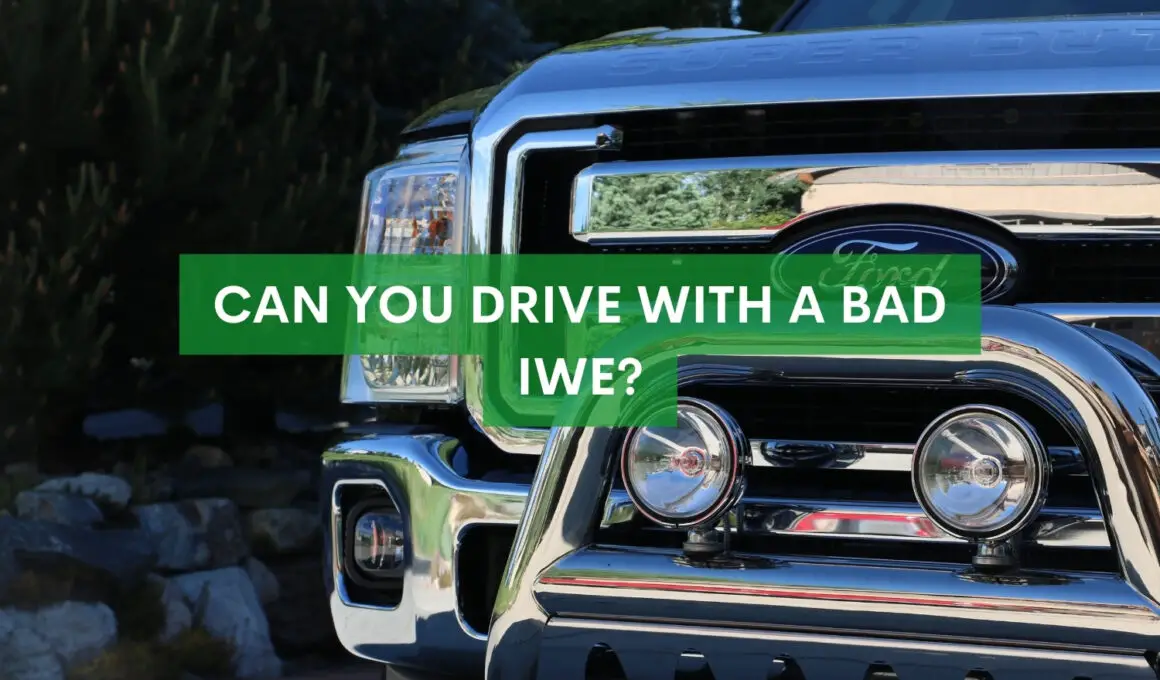In This Article Show
As an experienced mechanic with over 13 years in the field, I’ve encountered many issues that car owners face. One particular issue that I’ve seen more often than you’d think involves the Integrated Wheel End (IWE) in Ford trucks and SUVs.
It’s an essential but often overlooked component that plays a crucial role in your vehicle’s operation, especially when switching between two-wheel drive (2WD) and four-wheel drive (4WD).
The importance of understanding the role and function of the IWE can’t be overstated. Ignoring problems with your IWE could lead to more significant concerns down the road, both for your vehicle’s performance and your safety.
That’s why I’ve put together this guide—to shed some light on what an IWE is, how to recognize when it’s failing, and most importantly, whether you can drive safely with a bad one.
What is an Integrated Wheel End (IWE)?
Let’s start with the basics. The Integrated Wheel End, often abbreviated to IWE, is like the unsung hero in many Ford trucks and SUVs. Even with 13 years of experience as a mechanic, I still encounter many vehicle owners who aren’t quite familiar with its function.
So, in simple terms, the IWE acts as a switch for your front wheels, allowing them to engage or disengage from the drive system. Think of it as the bridge between 2WD and 4WD. In 2WD mode, the IWE disengages the front hubs, ensuring they’re free-rolling and not driven by the engine.
But when you need that extra traction and power, say when you’re tackling rough terrains or slippery conditions, switching to 4WD mode engages the IWE. This effectively connects the front hubs to the drivetrain, delivering power to all four wheels.
It’s like having a two-in-one vehicle – offering the fuel efficiency of a 2WD when you’re cruising on highways and the robust capability of a 4WD when things get tough.
And while the concept seems simple enough, its mechanics are sophisticated and finely-tuned, requiring timely maintenance and attention. But more on that later!
Signs of a Failing IWE
Knowing when something is amiss with your vehicle can save you from hefty repair bills and potential road mishaps. The IWE, like any other component, will show signs when it’s not functioning optimally. Being able to spot these early warnings can be a real game-changer. Here are some of the most common signs to watch out for:
1. Grinding or Growling Noise
If you start hearing a grinding sound from the front end, especially when in 2WD mode, it’s a classic indication that the IWE isn’t disengaging correctly. This noise isn’t just a minor annoyance—it’s your vehicle telling you something’s wrong.
2. Difficulty Switching Between 2WD and 4WD
If your vehicle resists or hesitates when you try to switch drive modes, or if you notice a delay, this can point to an IWE issue.
3. Unusual Tire Wear Patterns
This might be a bit harder for the untrained eye to spot, but a malfunctioning IWE can lead to uneven wear on your front tires. If one or both front tires are wearing out faster than the rear ones, or if you notice strange patterns like only the inner or outer edges wearing down, it’s worth checking the IWE.
4. Engagement in 4WD Even When Not Activated
If you feel like your vehicle is in 4WD mode, even when you haven’t activated it, it might be a sign that the IWE is stuck in the engaged position.
Remember, vehicles have their own unique ways of communicating problems. While these are some common signs, always trust your instincts. If something feels off or a new noise or behavior emerges, it’s worth checking it. It’s always better to be safe than sorry!
Risks of Driving with a Malfunctioning IWE
Driving with a faulty IWE isn’t just a matter of coping with a few odd noises or dealing with a slightly rougher ride—it can present some genuine concerns for both the health of your vehicle and your own safety. Here’s what you should be aware of:
1. Potential for Increased Tire Wear and Damage
When the IWE fails to disengage correctly in 2WD mode, it can cause the front tires to wear out unevenly and much faster than they would typically. Not only does this mean you’ll need to replace your tires sooner, but worn tires also reduce your vehicle’s grip on the road, posing a safety hazard, especially in wet conditions.
2. Risk of Damaging Other Components
A malfunctioning IWE doesn’t operate in isolation. It can place undue stress on adjacent parts like the CV joints and drive shaft when it’s not working correctly. Over time, this can lead to premature wear or even failure of these components, escalating repair costs.
3. Reduced Vehicle Handling
One of the primary reasons you’d switch to 4WD is to gain better traction in challenging conditions. If your IWE is acting up and not engaging or disengaging properly, you might find your vehicle harder to steer or control, especially on rough or slippery terrains.
4. Safety Concerns
Ultimately, any vehicle component that’s not functioning as it should poses a safety risk. Whether it’s reduced grip from uneven tire wear, decreased handling, or the potential for sudden component failures, driving with a bad IWE can compromise your safety and that of others on the road.
While it might be tempting to put off repairs—either to save on immediate costs or due to the belief that it’s not a critical issue—remember that neglecting a malfunctioning IWE can lead to more significant problems down the line.
And when it comes to safety, it’s always better to err on the side of caution.
Why IWEs Fail
Every vehicle component has its vulnerabilities, and IWEs are no exception. While they’re designed for longevity and performance, various factors can lead to their malfunction or failure. Understanding these can help you in prevention and early detection. Here are some common culprits:
1. Wear and Tear
Just like any other moving part in your vehicle, the IWE is subject to wear and tear over time. Frequent switching between 2WD and 4WD, or heavy off-road use, can accelerate this wear, leading to potential failure.
2. Faulty Solenoids
The solenoid is a crucial component in the IWE system, controlling the flow of vacuum that engages or disengages the hubs. It can prevent the IWE from operating correctly if it malfunctions or fails.
3. Vacuum Leaks
The IWE system in Ford vehicles relies on a vacuum to function. If there’s a leak in the vacuum lines or if the vacuum reservoir is compromised, the system might not get the necessary pressure to engage or disengage the hubs.
4. Environmental Factors
The location of the IWE makes it particularly vulnerable to external elements. Mud, water, sand, and even road salt can enter the system and cause blockages or corrosion. Regularly driving through rough terrains or waterlogged areas can increase this risk.
5. Manufacturing Defects
While not as common, sometimes IWEs can fail due to inherent manufacturing defects. This isn’t something you can control, but it’s worth keeping in mind, especially if you notice problems early in a vehicle’s life.
6. Improper Previous Repairs
If the IWE or nearby components have been serviced or replaced and not done correctly, it can lead to subsequent failures. Always ensure you’re working with a trusted mechanic who understands the intricacies of the IWE system.
By being aware of these potential pitfalls, you’re better equipped to ensure the longevity and health of your IWE system. Regular checks and maintenance can often prevent or mitigate many of these issues, ensuring smooth driving for miles to come.
By being aware of these potential pitfalls, you’re better equipped to ensure the longevity and health of your IWE system. Regular checks and maintenance can often prevent or mitigate many of these issues, ensuring smooth driving for miles to come.
How to Address a Bad IWE
Discovering you might have an issue with your IWE can be concerning, but don’t fret. Addressing the problem promptly and correctly can prevent further complications and ensure your vehicle remains safe to drive. Here’s a step-by-step guide on how to tackle a bad IWE:
1. Seek a Professional Diagnosis
The symptoms of a failing IWE can sometimes overlap with other vehicle issues. It’s essential to have a trusted mechanic diagnose the problem accurately. They will check the vacuum system, solenoids, and the IWE itself for any signs of malfunction.
Pro Tip 👋
Need to talk to a professional with a special discovery on your car issue? Use this link to talk to a professional. This is in partnership with JustAnswer, which has an on-call expert who can help you, especially during an emergency. Talk to a master mechanic now.
2. Avoid Driving, If Possible
If your IWE is showing clear signs of malfunction, it might be best to avoid driving your vehicle, especially long distances or on challenging terrains. This will reduce the risk of causing further damage or compromising your safety.
3. Understand the Repair Process
If a diagnosis confirms a faulty IWE, your mechanic will typically advise on one of two routes: repairing the current system or replacing the IWE altogether. Depending on the extent of the damage, sometimes a replacement is more cost-effective in the long run.
4. Inquire About Costs
IWE repairs or replacements can vary based on the vehicle model, the specific issue, and labor rates. Always get a clear estimate before proceeding with any work, and don’t hesitate to ask questions if you’re unsure about any aspect of the repair.
5. Check for Warranty or Recalls
Specific vehicle models might sometimes have known issues with their IWEs, leading to manufacturer recalls. Check if your vehicle qualifies for any such recalls or if the repair might be covered under a warranty.
6. Consider Preventative Measures
Once your IWE issue is addressed, ask your mechanic about preventive measures. Regular checks, ensuring the vacuum system is intact, and avoiding certain environmental hazards can extend the life of your IWE and reduce the likelihood of future problems.
Bottom line
By staying proactive and informed, you can ensure a bad IWE is but a minor hiccup in your vehicle’s journey, rather than a long-term headache.










